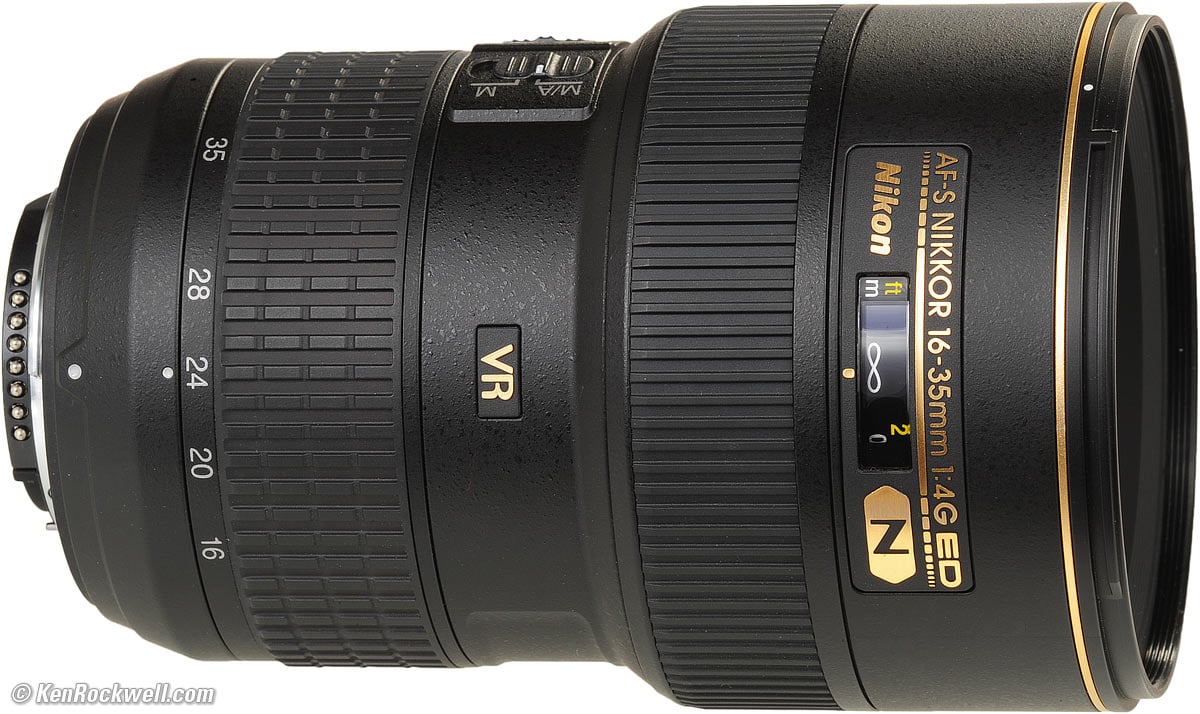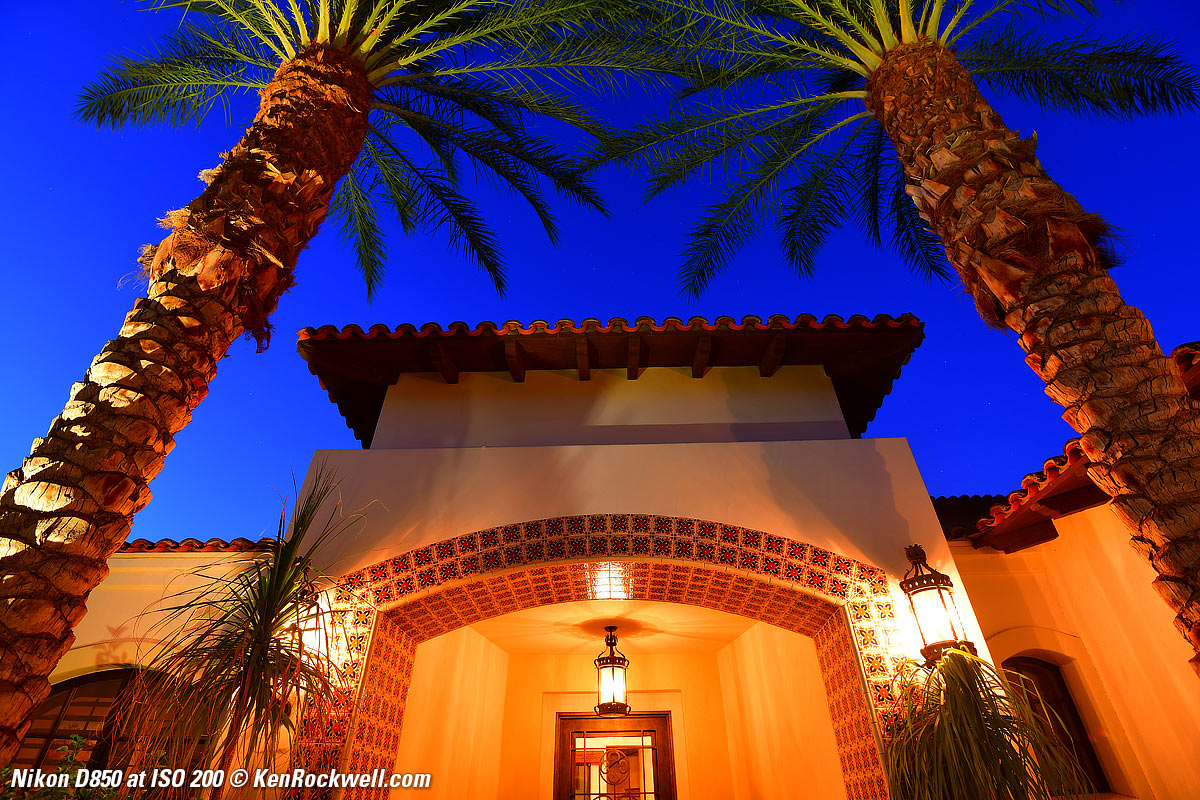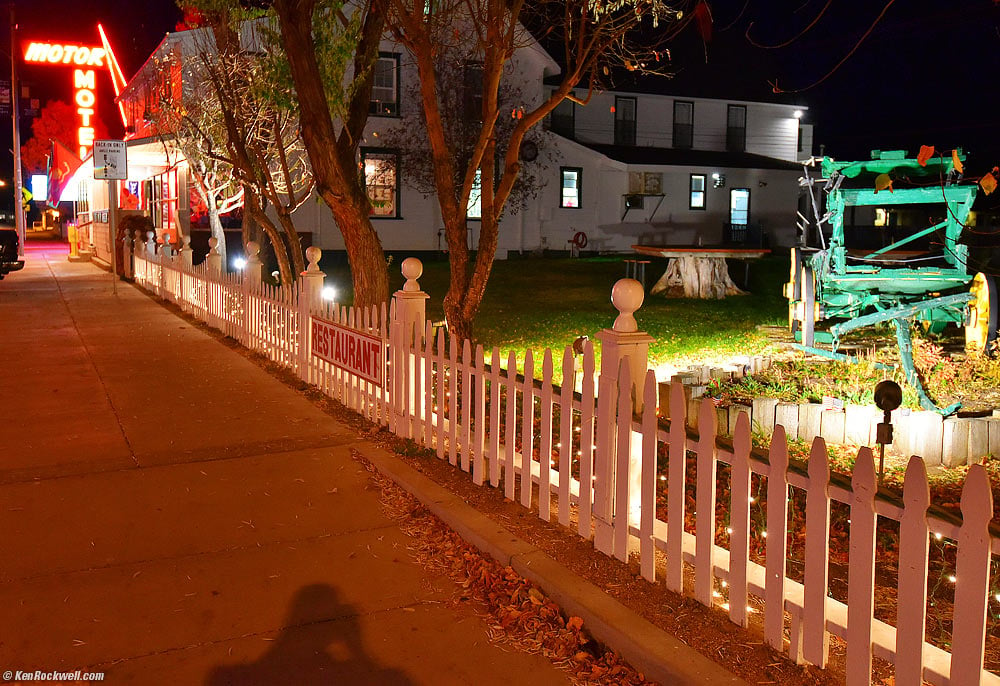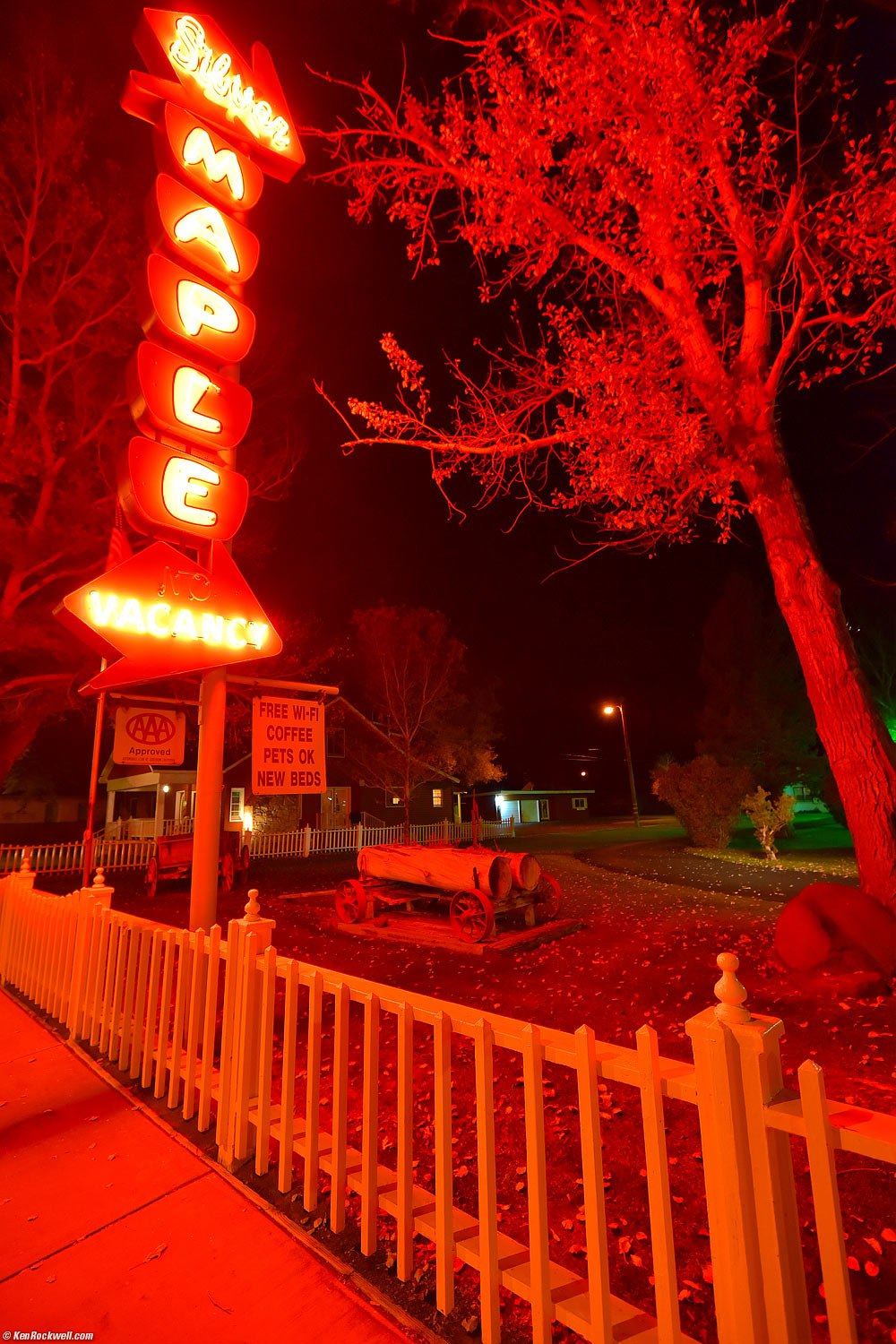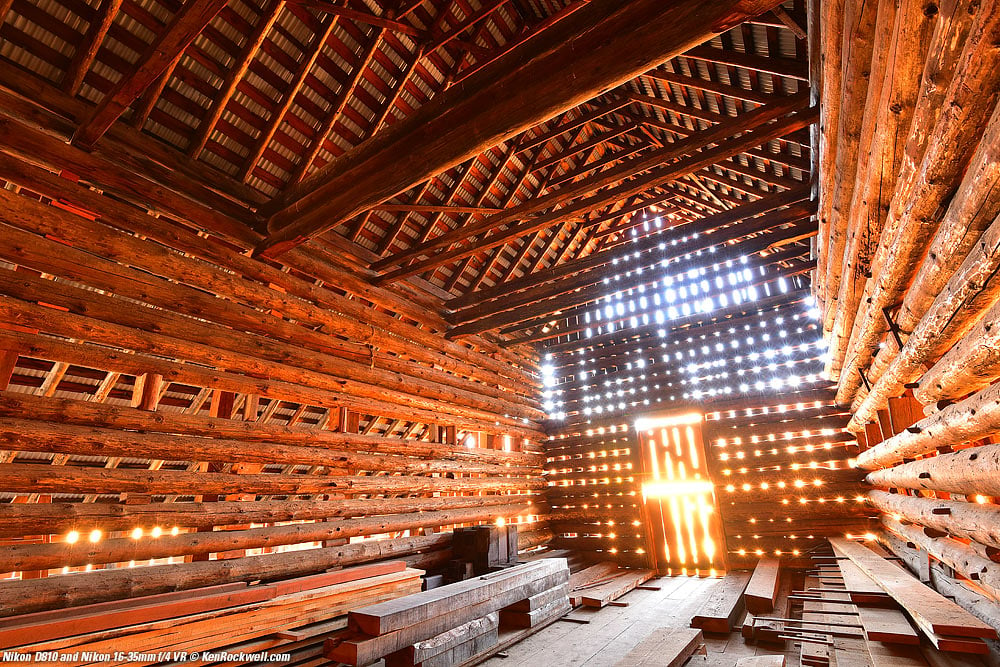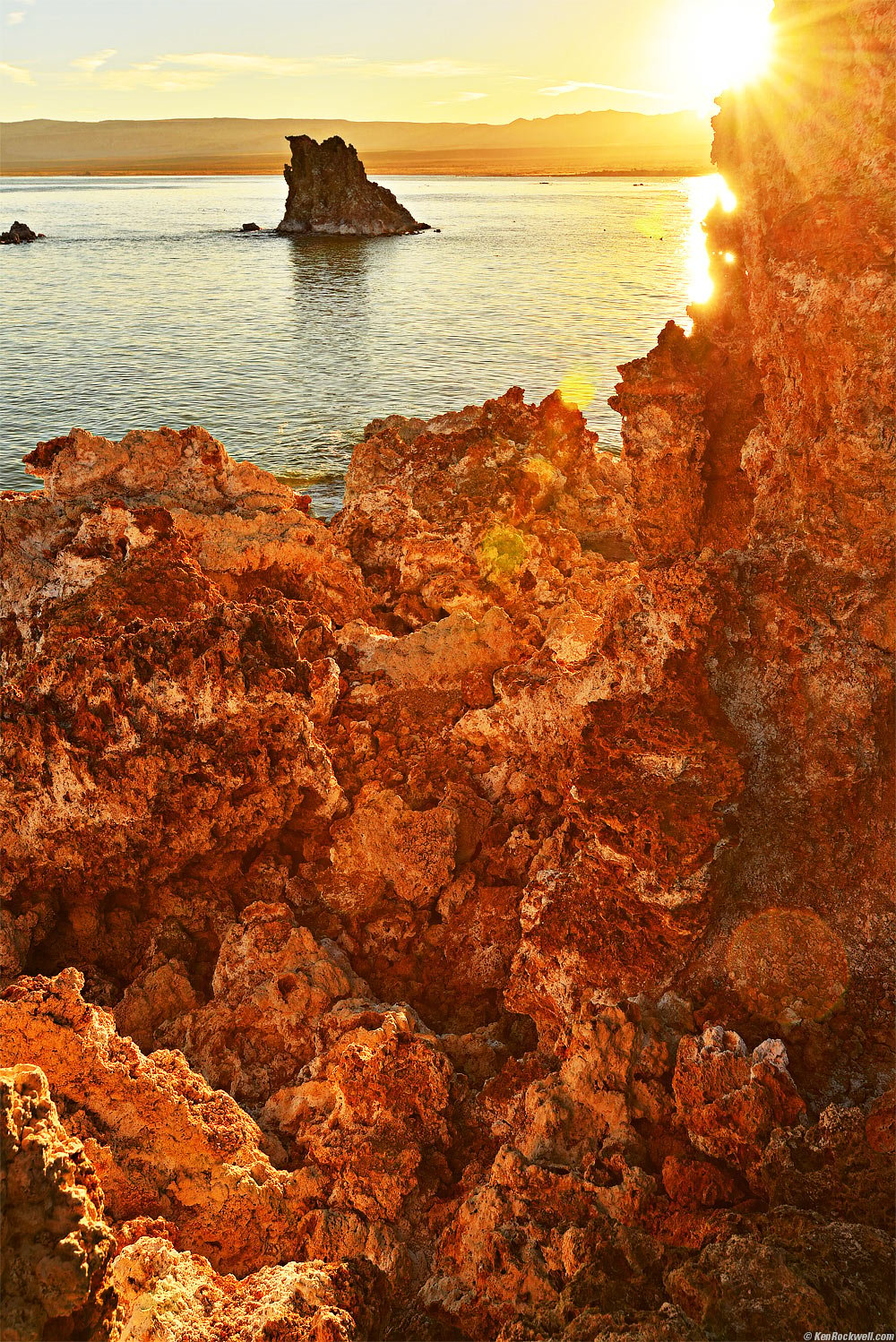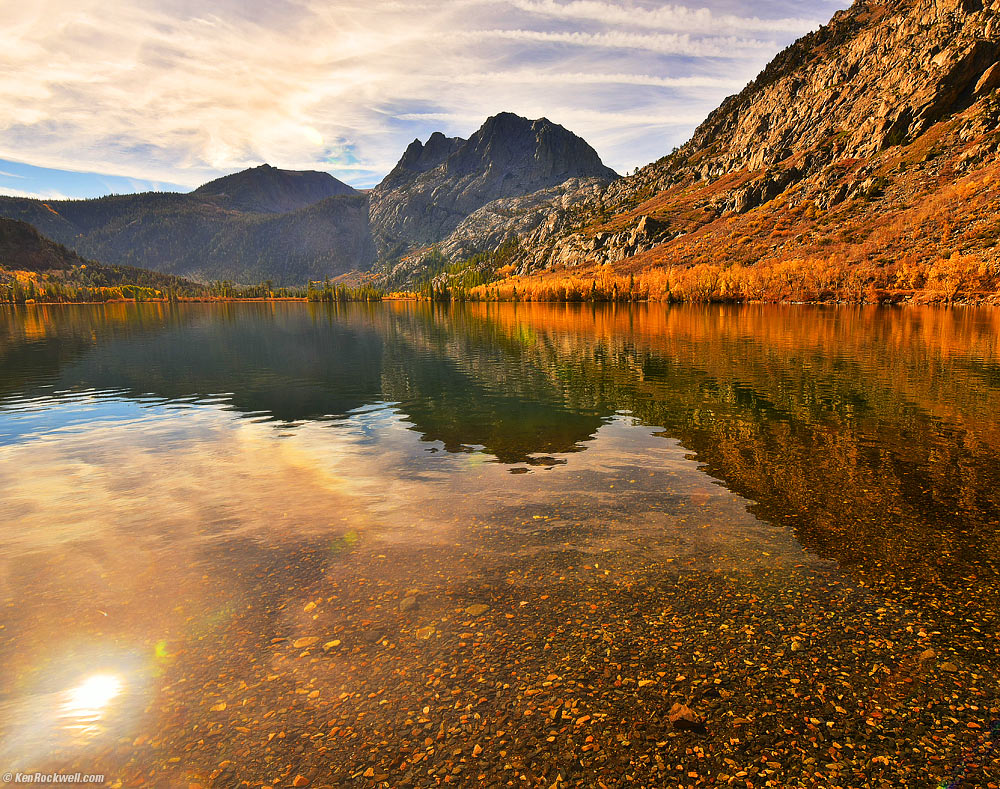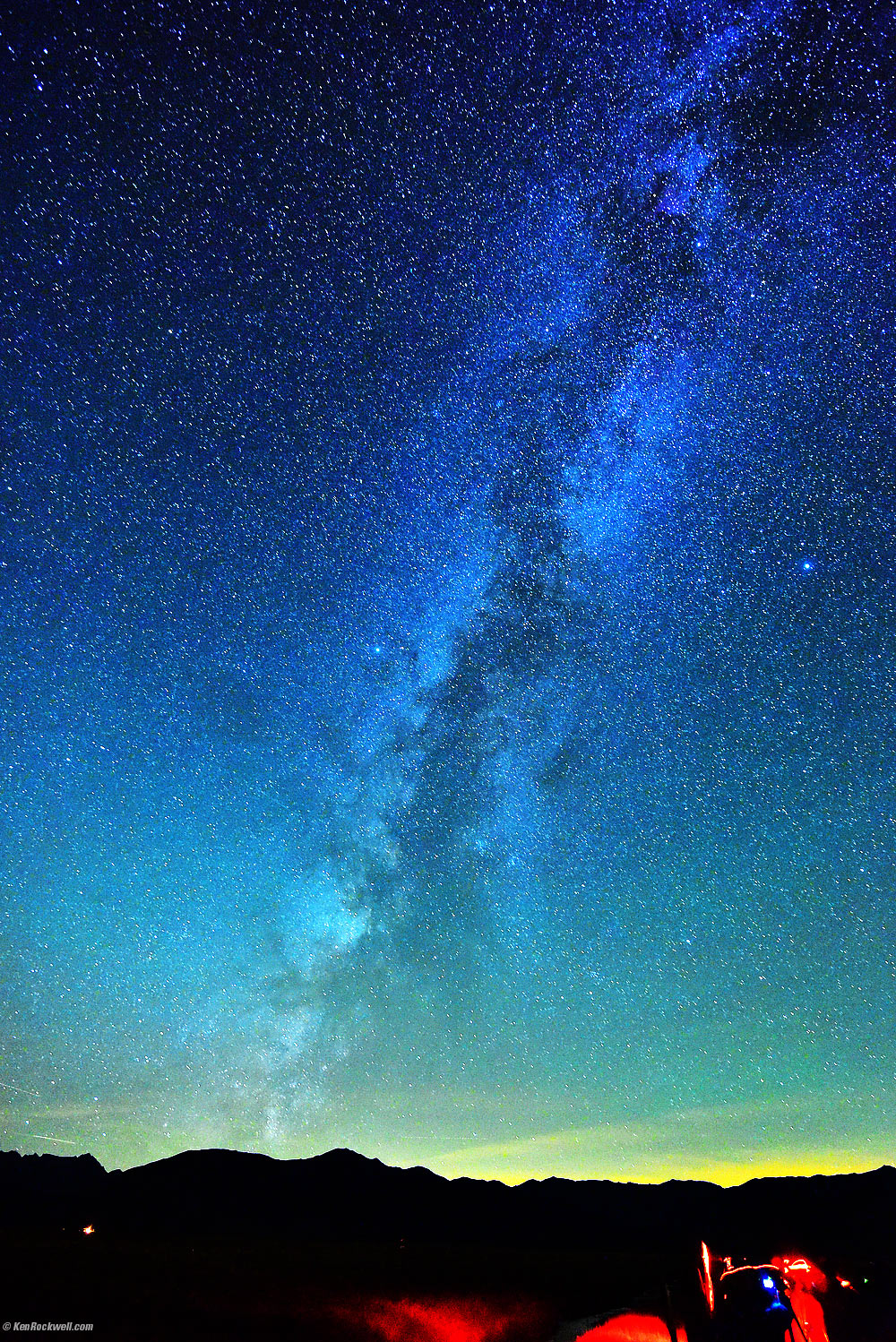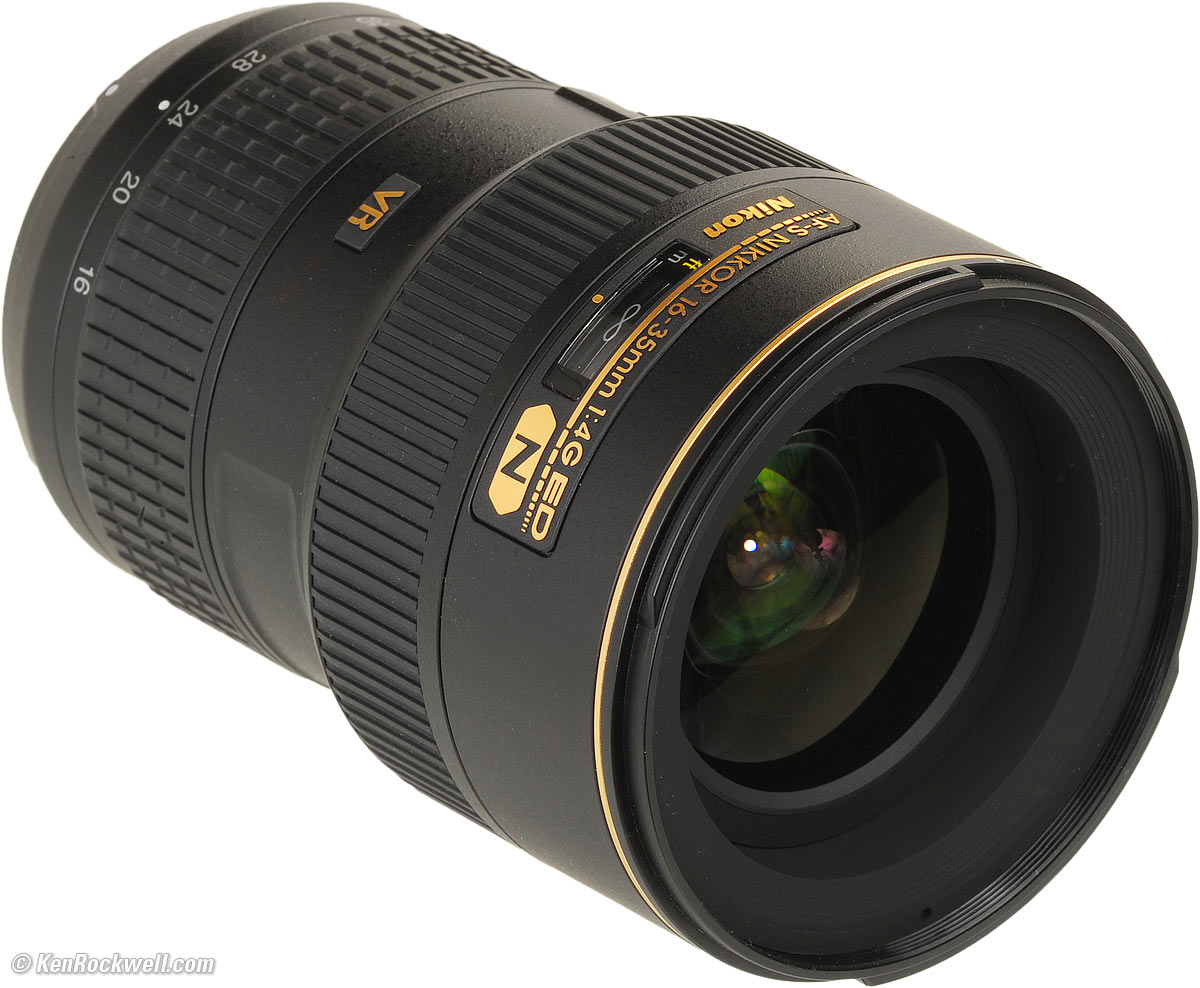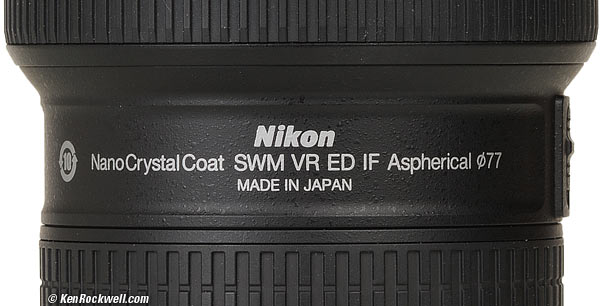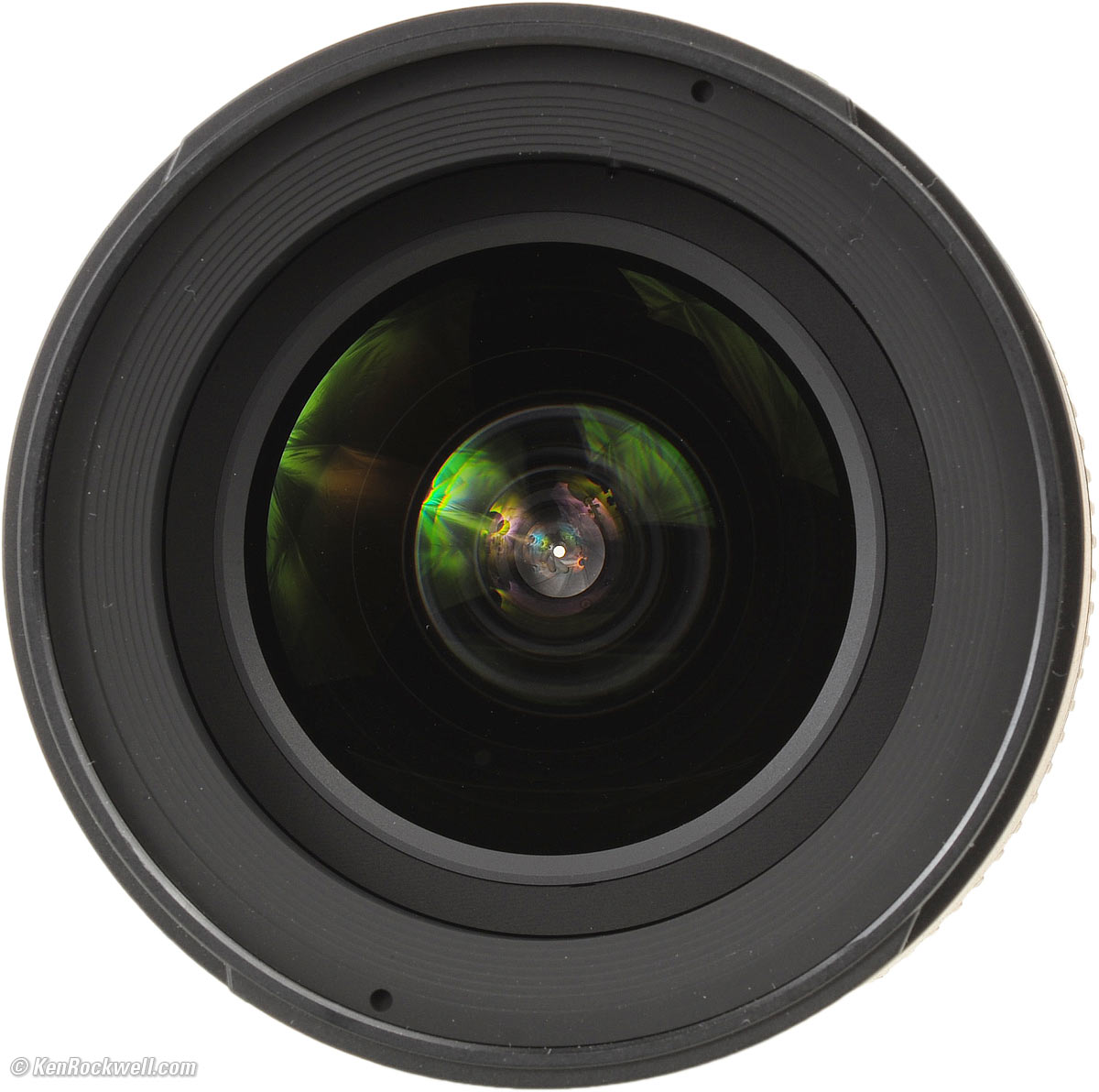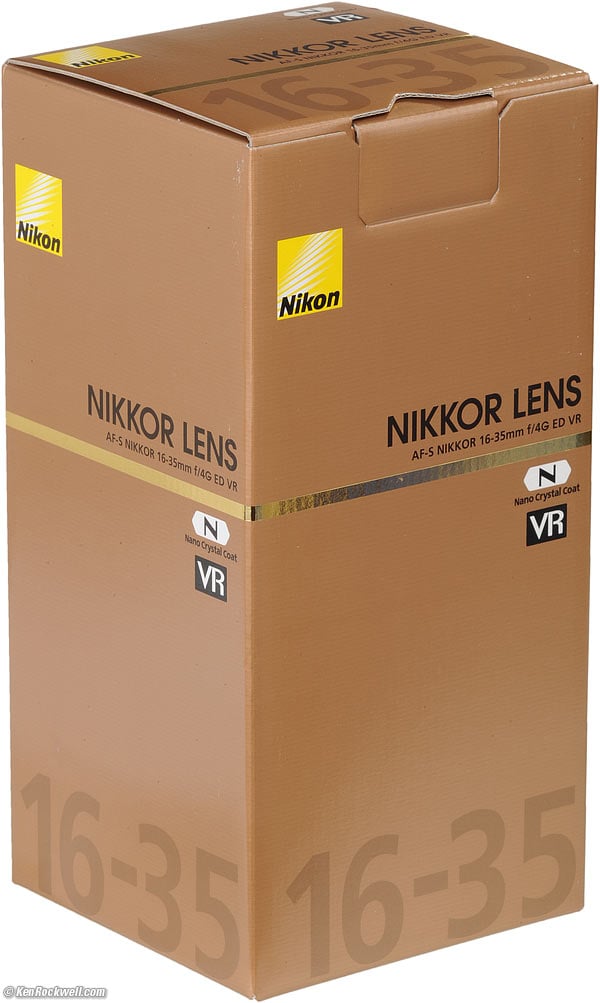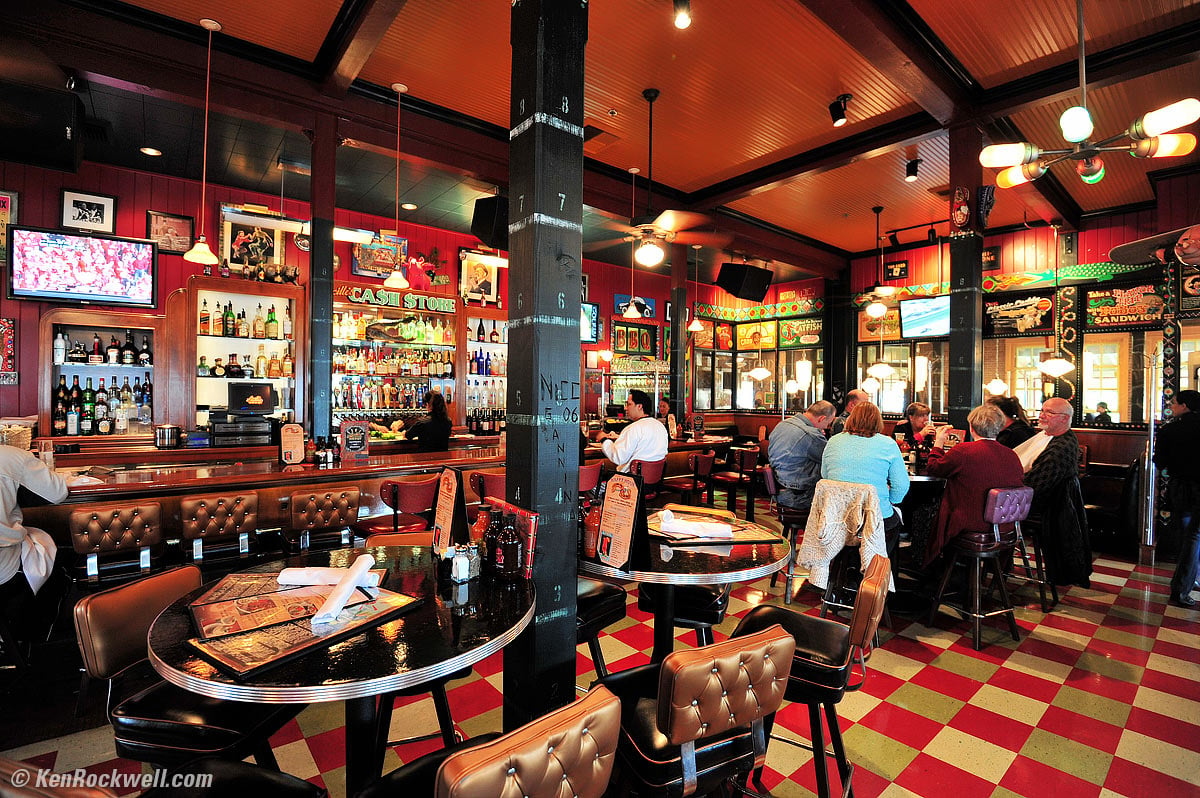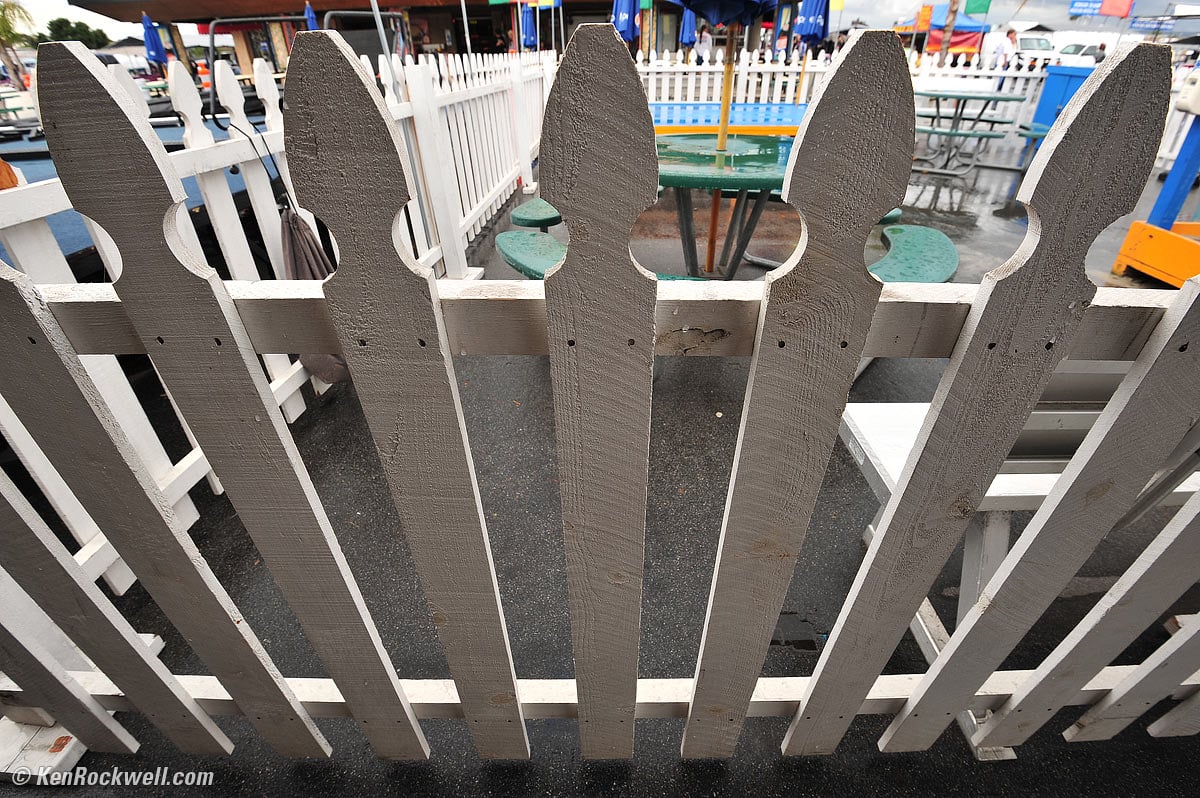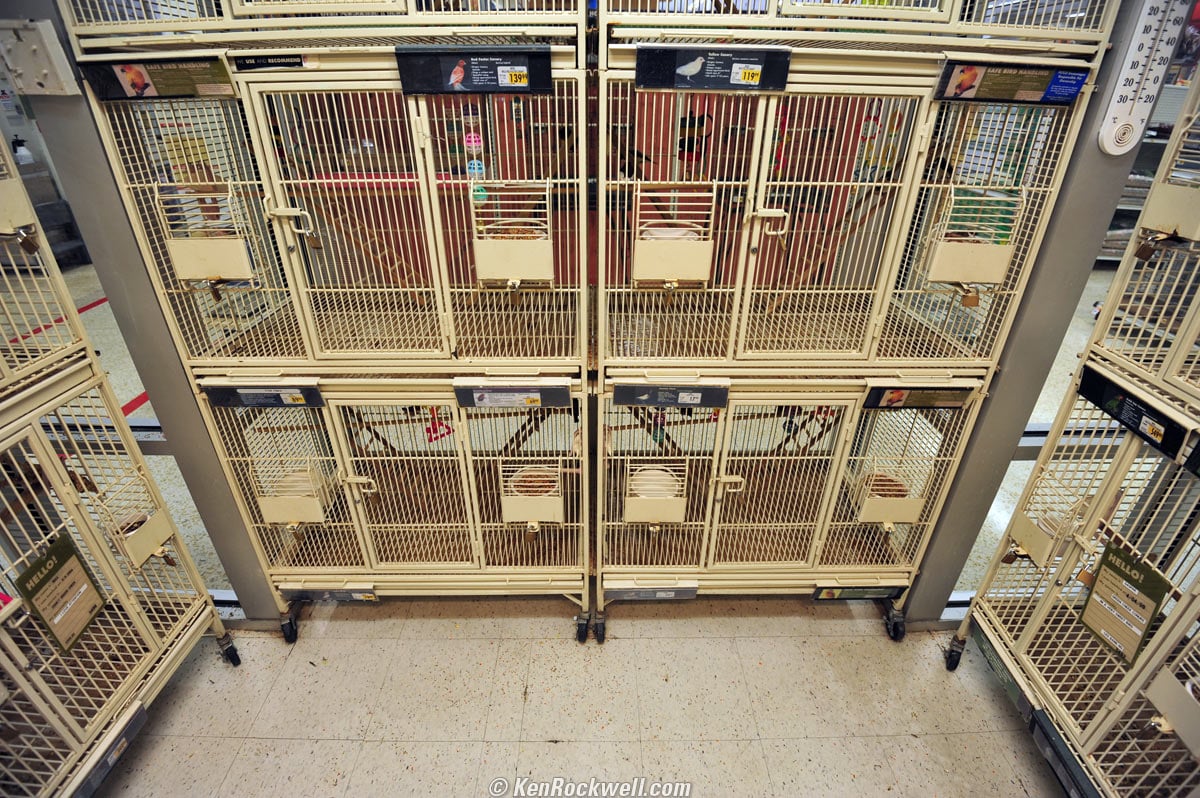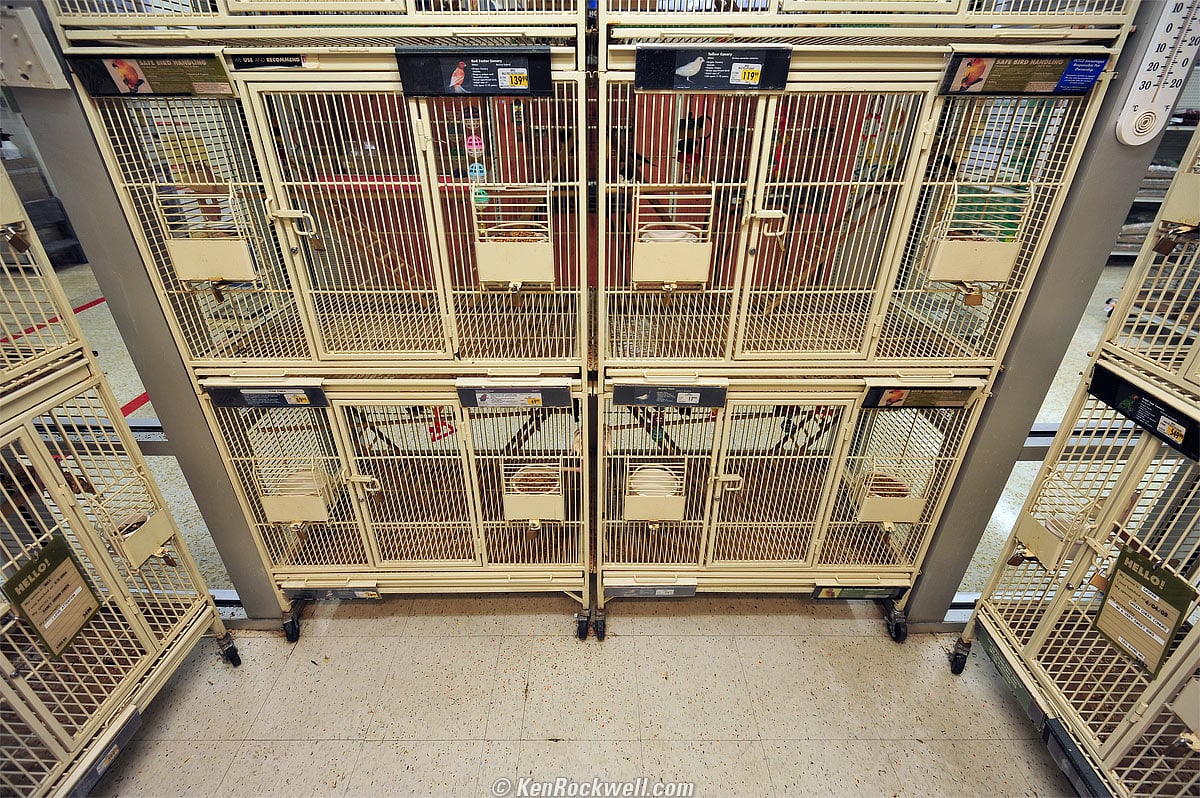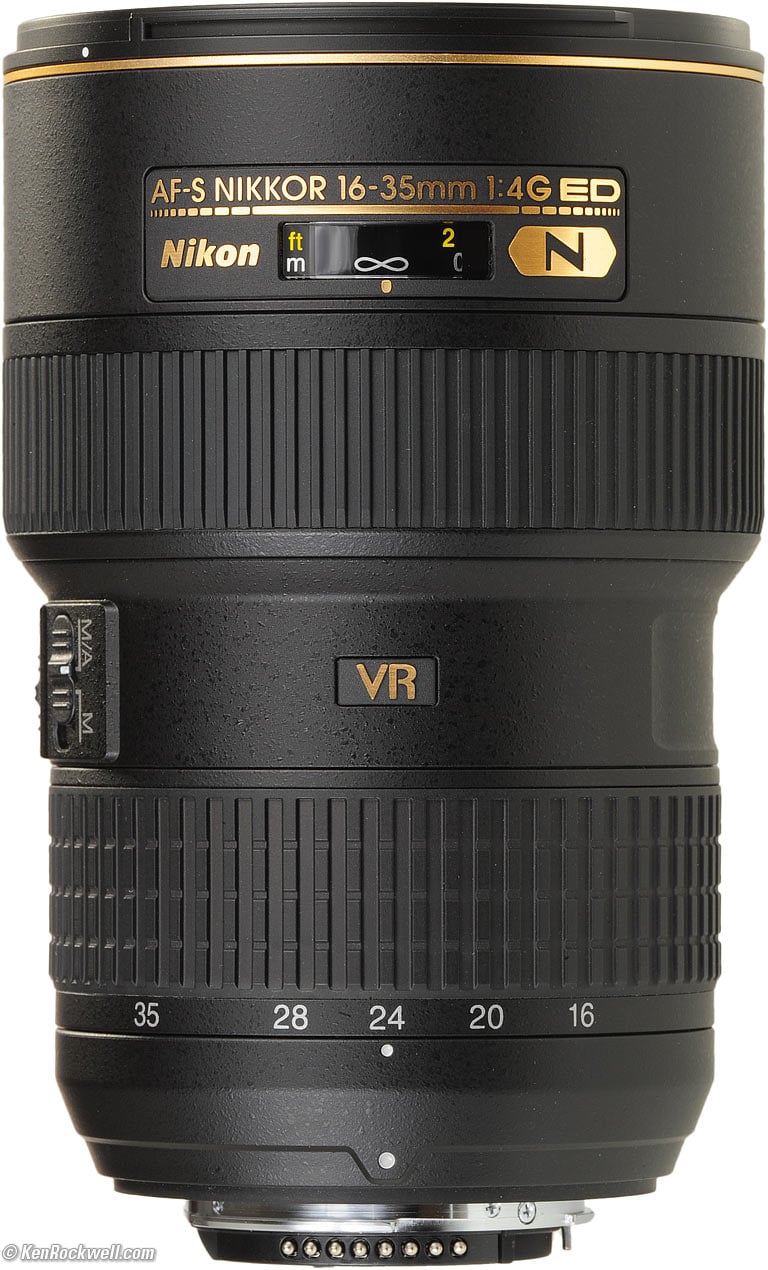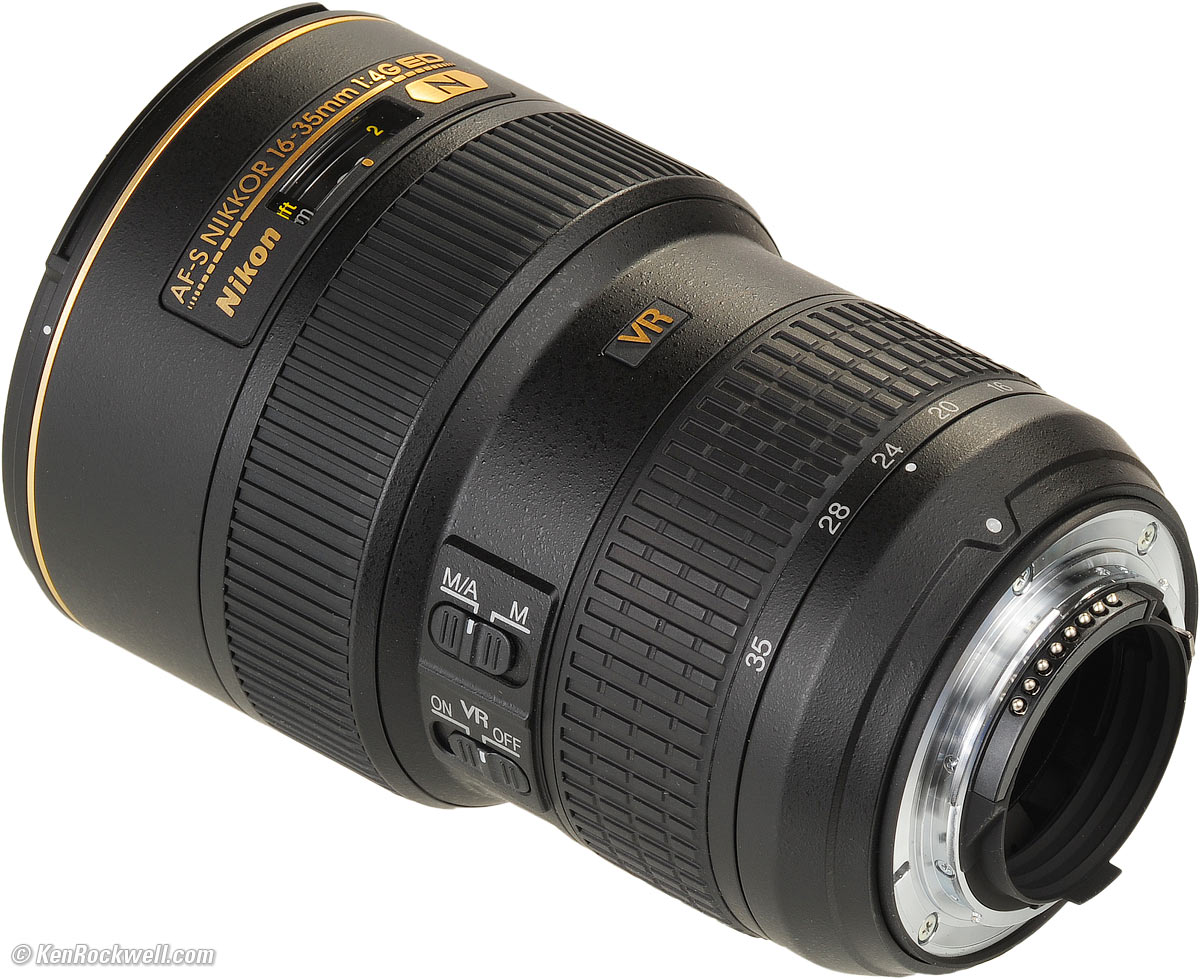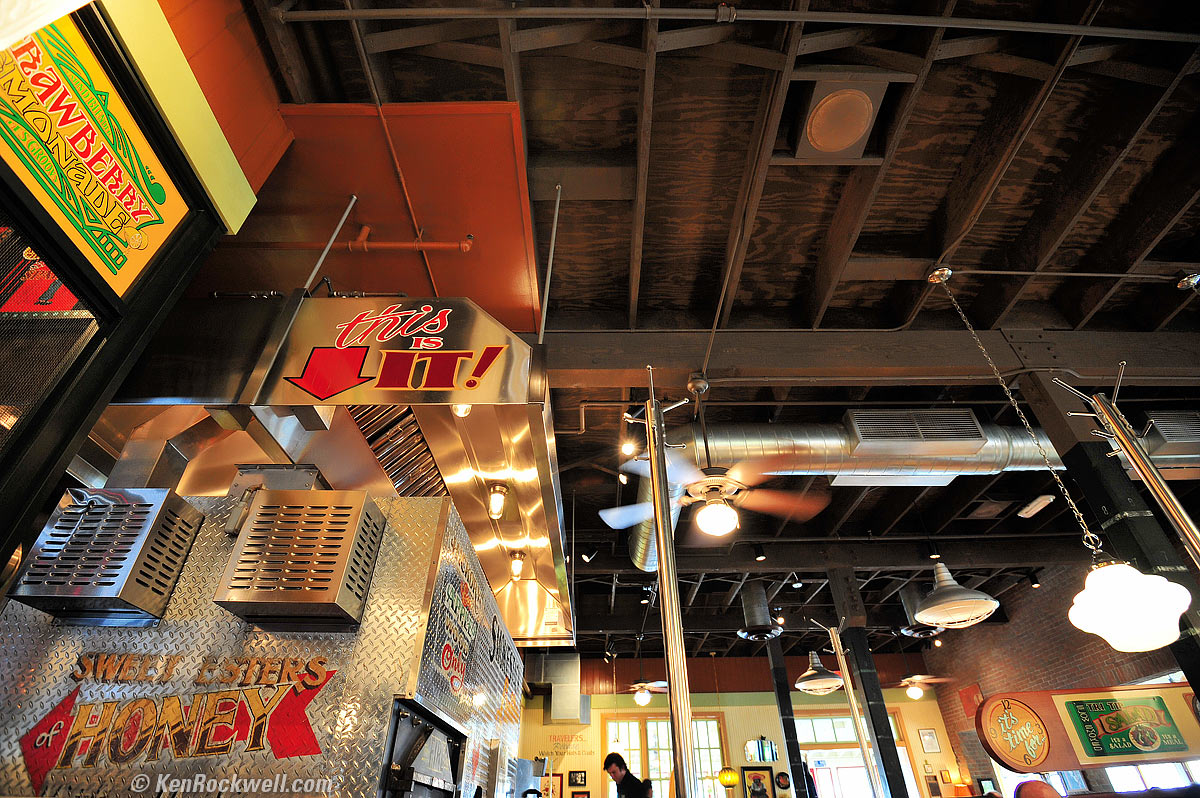Nikon 16-35mm VR
Full-Frame FX VR f/4 (2010-2022)
Compatibility Specs Performance
Nikon 16-35mm f/4 AF-S VR G ED IF N Aspherical (77mm filters, 23.9 oz./678g, 1'/0.29m close focus, about $450 used if you know How to Win at eBay). enlarge.
This all-content, junk-free website's biggest source of support is when you use those or any of these links to approved sources when you get anything, regardless of the country in which you live. Thanks for helping me help you! Ken.
November 2022 Better Pictures Nikon Reviews Nikon Lenses Nikon Flash All Reviews
Full-Frame Ultrawide Lenses Compared 24 June 2017
Nikon 17-35/2.8 ED (1999-)
Canon 16-35/4 L IS (2016-)
Canon 16-35/2.8 L III (2016-)
Sony Zeiss 16-35/4 OSS (2014-)
Sony 16-35/2.8 GM (2017-)
Sample Images
Top Sample Images Intro Format
Compatibility Specs Performance
Sample image: California State Capitol Dome, Sacramento. Nikon 16-35 VR set to 16mm, f/4 at 1/15 at ISO 200 on FX hand-held. Full-resolution image.
Desert Home, 26 September 2017, 7:12 PM. Nikon D850, Nikon 16-35mm VR at 16mm, 15 seconds at f/7.1 at ISO 200. bigger or camera-original LARGE NORMAL JPG.
Great Room, Ahwahnee Hotel, Yosemite Valley, 18 October 2014, 8:04 AM. (Nikon D810, Nikon 16-35mm VR at 16mm, f/4 at 1/8 hand-held at Auto ISO 200.) Bigger or Camera-original © MEDIUM BASIC JPG file.
Self Portrait, Bridgeport, California, 19 October 2014, 7:10 PM. (Nikon D810, Nikon 16-35mm VR at 31mm, f/4 at 1/15 hand held at ISO 3,200, Athentech Perfectly Clear v2.) bigger.
Silver Maple Motel after Dark, Bridgeport, California, 19 October 2014, 7:10 PM. (Nikon D810, Nikon 16-35mm VR at 16mm, f/4 at 1/8 hand held at ISO 1,400, Athentech Perfectly Clear v2.) bigger.
Barn, Yosemite National Park, 19 October 2014, 8:19 AM.(Nikon D810, Nikon 16-35mm VR at 16mm, f/8 at 30 seconds at ISO 200.) Bigger or Camera-original © LARGE NORMAL JPG.
Backlit Tufa during Brilliantly Glorious Sunrise, Mono Lake, 21 October 2014, 7:40 AM. (Nikon D810 HDR mode, Nikon 16-35mm VR at 30mm, f/11 at 1/80 hand held at ISO 100, Athentech Perfectly Clear v2.) Bigger. I set Shade white balance to make this look as it should. In person, they only looked pale yellow, not vivid orange.
Morning Glow, Silver Lake, 21 October 2014, 10:10 AM. (Nikon D810 HDR mode, Nikon 16-35mm VR at 16mm, Shade white balance, f/11 at 1/125 at ISO 100, Athentech Perfectly Clear v2.) Bigger.
The Milky Way as Seen from Bridgeport, 21 October 2014, 9:33 PM. (Nikon D810, Nikon 16-35mm VR at 16mm, f/4 for 30 seconds at ISO 12,800.) Bigger. See also How to Photograph the Milky Way.
Sample Photographs from Yosemite and California's Eastern Sierra October 2014
Yosemite October 2011
California's North Coast August 2010
California's Central Coast June 2010
Nikon 16-35mm © sample image file at ISO 1,100
Nikon 16-35mm © sample image file at ISO 1,000
Introduction
Top Sample Images Intro Format
Compatibility Specs Performance

I buy only from these approved sources. I can't vouch for ads below. |
The Nikon 16-35mm VR is the sharpest Nikon ultrawide lens I've ever used. Under test conditions, it's even slightly sharper than the old king, the beastly Nikon 14-24mm.
This Nikon 16-35mm is so good that there isn't much to write about. It's ultra-sharp, it has no significant light falloff in the corners, distortion is reasonable from 20-35mm, focus and zooming are easy and perfect, and it focuses to within just inches in front of the lens.
The 16-35mm's weakest points are its heinous, but easy-to-correct, distortion at 16mm, and it's giant size; five inches (125mm) long. Nikon's first ultrawide zoom, the 20-35mm f/2.8 AF-D (1993-2001), is a stop faster, built pro-tough (unlike this 16-35mm), and is still smaller and lighter, but the 20-35mm has nowhere near the optical performance of this new 16-35mm f/4.
The 16-35mm is Nikon's newest ultrawide zoom. It covers the full FX frame for use with both FX and 35mm RealRaw cameras.
The 16-35mm VR is also Nikon's widest FX lens ever that works with front-mounted filters. The older 15mm f/3.5, 15mm f/5.6, 14mm f/2.8 AF-D and 13mm f/5.6 had such bulbous fronts that no filter could cover them. The front element of this Nikon 16-35mm lens is tiny by comparison.
This new 16-35mm is a huge step up from the 14-24mm because it's much smaller and lighter, has a much more useful zoom range, takes filters both for protection and for use with RealRaw, and is even a little sharper. There's no question that it's time to sell your 14-24mm and get this smaller, lighter and far more practical 16-35mm instead.
VR isn't a big deal. It only gets a stop or two of improvement for hand-held low-light shots of still subjects, which makes it about even with an f/2.8 lens. I do prefer shooting at f/4 with VR over f/2.8 without VR for depth-of-field, but for low light wide angle shots, nothing today compares with the new Nikon 24mm f/1.4 AF-S.
Compared to the hard-to-get professional 17-35mm f/2.8, this 16-35mm VR is $500 less expensive and otherwise similar in size and weight. This 16-35mm VR is however a little lighter, a little longer, and it's sharper if you're picky.
This 16-35mm f/4 VR just became my top recommendation for an FX ultrawide zoom.
Bravo, Nikon!
I 'd get my 16-35 VR used at eBay (How to Win at eBay).
Great for
This is the best Nikon wide-angle lens ever for most shooting.
For subjects that hold still, shooting this 16-35mm at f/4 with VR hand-held gives much sharper images than shooting a faster lens at a wider aperture, because more is in focus at f/4 than at f/2.8 or f/1.4.
I have no problem shooting this lens hand-held in the darkest light outdoors on digital, and therefore prefer it over the 24mm f/1.4 AF-S G, whose larger apertures get less in focus. With digital, no one really needs f/1.4 except for action, making this 16-35mm perfect for almost everything.
Not for
Not for low-light action shots, where VR can't help you. In very dim light with moving subjects, get the 24mm f/1.4 AF-S G instead.
Don't even think about this lens for use on DX. Yes, it works great, but you're throwing away most of the performance for which you paid and carrying way too much weight for what you're getting on DX. For use on DX, use a DX lens like the 18-55mm VR, 16-85mm VR, 17-55mm f/2.8 or 10-24mm are much better ideas.
Format
Top Sample Images Intro Format
Compatibility Specs Performance
I 'd get my 16-35 VR used at eBay (How to Win at eBay).
This is a full frame FX lens, and I'm reviewing it as such.
The 16-35 VR covers FX, 35mm film and DX.
It works great on DX cameras, too, on which you may make the usual inferences, however it's a waste to use it on DX, since you're not using most of the lens — just the central part. For use on DX, any of the10-20mm, 18-55mm VR, 16-85mm VR, 17-35mm f/2.8 or 10-24mm are much better ideas.
Compatibility
Top Sample Images Intro Format
Compatibility Specs Performance
I 'd get my 16-35 VR used at eBay (How to Win at eBay).
Everything works perfectly on every digital Nikon, both FX and DX, and even on Nikon's cheapest digitals like the D40, D40x, D60, D3000 and D5000.
It's also perfect on decent or recent AF film cameras like the F6, F100, F5, N80 and N75.
The incompatibilities for older or cheaper film cameras are that:
1.) It won't autofocus with the cheapest AF film cameras like the N55, but if you focus manually, everything else works great. Even if you lose autofocus, these cameras have in-finder focus confirmation dots to help you.
2.) Late 1980s ~ early 1990s AF cameras like the N90s, N70 and F4 will focus just fine, but you'll lose VR. You'll have Program and Shutter-priority modes, but lose Manual and Aperture-priority since you have no way to set the aperture on the camera or on the lens.
3.) You're really pushing it with the oldest AF cameras like the N2020, N6006 and N8008. You'll have no AF, confused exposure modes, and no VR. Manual focus is fine, along with electronic focus indications.
4.) Since it has no aperture ring, it's just about useless with manual focus film cameras.
See Nikon Lens Compatibility for details with your camera. Read down the "AF-S, AF-I," "G" and "VR" columns for this lens. You'll get the least of all the features displayed in all columns, since "G" (gelding) is a handicap which removes features.
Nikon 16-35mm VR. enlarge.
Specifications
Top Sample Images Intro Format
Compatibility Specs Performance
I 'd get my 16-35 VR used at eBay (How to Win at eBay).
Nikon 16-35mm Alphabet Soup. enlarge.
Name
Nikon AF-S NIKKOR 16-35mm f/4G ED VR N.
Nano Crystal Coat (N): Magic anti-reflection coating that has a variable index of refraction that's far more effective than multicoating.
AF-Sand SWM: Silent Wave Autofocus Motor.
VR: Vibration Reduction.
ED: Magic ED Glass.
G: Gelded for cost-reduction and removing compatibility with older cameras.
IF: Internal focusing; nothing moves externally as focused.
Aspherical (ASPH): Specially curved glass to give even sharper pictures.
∅77: 77mm filter thread.
Optics

Nikon 16-35mm internal construction. Aspherical and ED elements.
17 elements in 12 groups.
Two are of magic ED glass.
Three are aspherical.
Nano Crystal Coat is used on at least one surface, so ghosting should be minimal to nonexistent.
Format Coverage
Also works great on DX, although the 18-55mm VR, 16-85mm VR, 17-35mm f/2.8 or 10-24mm make much more sense on DX.
Focal Length
Actual focal length: 16-35mm.Equivalent on on FX and RealRaw: 16-35mm.
Equivalent on small-format DX: 24-50mm.
Angle of View
107° - 63° on FX and RealRaw.
83° - 44° on small-format DX.
Diaphragm
Nikon 16-35mm VR at f/22. enlarge.
9 rounded blades.
Stops down to f/22.
Filter Thread
77mm, plastic.
Does not move or rotate.
1 foot (0.29m), specified, from the image plane. I measure about 11" (280mm).
The image plane is at the back of your camera. You can focus much closer to the front of the lens.
Close focus is 11 or 12 inches from the image plane, however, the 16-35mm is five inches (125mm) long and your camera is typically 2 inches (50mm) deep, this means that close focus is just a few inches in front of your lens!
I can focus up to just 4 inches (100mm) from the front of the lens. If I used the included lens hood, there would be even less space between that hood and the closest subject on which I could focus.
Maximum Reproduction Ratio
1:4.
Hard Infinity Focus Stop?
No.
Focus Scale
Yes.
Depth-of-Field Scale
No.
Infra-Red Focus Index
No.
Vibration Reduction (VR)
Trade name "VR II."
Marked on lens: "VR."
Claimed improvement: "up to 4 stops."
Actual improvement: one or two stops.
Hood
HB-23 plastic bayonet hood, included.
This is the same hood as the 10-24mm DX, 12-24mm DX, 17-35mm f/2.8 AF-S and 18-35mm AF-D.
Case
CL-1120 pouch, included.
A tube sock works better.
Size
3.25" diameter x 4.92" extension from flange.
82.5 mm diameter x 125 mm extension from flange.
Weight
23.912 oz. (677.9g), measured.
24.0 oz. (680g), rated.
Included
Front and rear caps (LC-77 and LF-1)
HB-23 plastic bayonet hood.
CL-1120 pouch.
Nikon Product Number
2182.
Made in
Japan, at least the early sample seen here.
Nikon sometimes moves production to Thailand (18-200mm) or China (50mm) as a lens gets older.
Announced
09 February 2010.
Available
Since March 2010.
Price, USA
November 2022
About $450 used if you know How to Win at eBay.
No longer available new.
22 / 2 / 2022
$1,097 new at Adorama, at Amazon, at B&H and at Crutchfield.
or about $500 used if you know How to Win at eBay.
June 2019
$997 new or about $650 used if you know How to Win at eBay
Septamber 2017
$1,097 new or about $750 used if you know How to Win at eBay.
June 2017
$997.
April-November 2014
February 2014
$957.
August -November 2011
$1,140.
November 2010
$1,109.
August 2010
$1,110.
July 2010
$1,160.
June 2010
$1,200
April 2010
$1,250.
March 2010
$1,260.
Got mine at Adorama.
Packaging
Cardboard box.
Top holds a cardboard insert with the hood and lens pouch.
Bottom 2/3 of box holds lens between two white foam holders.
Paperwork slid in along the side.
Box, Nikon 16-35mm VR. enlarge.
Performance
Top Sample Images Intro Format
Compatibility Specs Performance
Overall Focus Bokeh Distortion Ergonomics Falloff
Filters Flash Ghosts Lateral Color Fringes Macro
Mechanics Sharpness Sunstars Survivability VR Zooming
I 'd get my 16-35 VR used at eBay (How to Win at eBay).
Overall performance top
Performance is superb.
This Nikon 16-35mm is ultra-sharp, has no significant light falloff, focus and zooming are perfect, and it focuses way too close.
Focus performance top
Focus is always fast and sure.
Typical for Nikon, every shot is right-on.
There are no surprises here.
It's trivial to go from auto to manual focus: just grab the focus ring for manual, and tap the shutter again to get back to auto.
The focus ring only turns if you turn it.
M/A - M Switch
Nikon goofed. This switch should be labeled "A - M."
The "M/A" position means autofocus. It's called "M/A" because you also can focus manually simply by grabbing the focus ring in this position.
Paint over the extra M if you're easily confused.
Focus Drift
Focus holds while zooming.
The sample of lens I use is well enough constructed that you can zoom after focusing, and it stays in focus.
It doesn't drift as zoomed.
Bokeh performance top
With a lens this wide and slow, almost nothing is out of focus.
If you can get a background out of focus, bokeh (the softness of the out-of-focus area) is excellent. Backgrounds never distract.
Distortion performance top
Distortion (curving of straight lines) is heinous at 16mm.
In fact, the Nikon 16-35mm f/4 VR, when set to 16mm, is the most distorting lens I have every used, short of a deliberate fisheye. The distortion goes away at other zoom settings.
Thankfully the distortion is simple and very easy to correct in Photoshop's lens distortion filter, so no big deal.
This distortion is usually completely invisible. If you're the sort of Poindexter who spends more time trolling the Internet looking for flaws than shooting, this lens will keep you busy whining for some time.
Here's how invisible it usually is:
Lucille's, 16mm at f/4, 1/15 sec. camera-original © file.
Since no lines run parallel to the edges of the frame and are close to the edges, there's nothing distorted.
OC Swap Meet at 16mm. bigger.
In this shot of a fence, few if any of the lines are parallel to, or near, the edges, so again, distortion is largely invisible.
If I shoot something with a straight line parallel and near an edge, it can look as bad as this:
Cage Nest at 16mm. bigger.
See the curving of the line along the top and the crack in the stick-on vinyl tiles below? That's how the distortion looks, worst case.
Plug +8 into Photoshop's lens distortion filter, and bingo, problem goes away:
Cage Nest at 16mm. bigger.
Not bad at all, considering it's shot wide-open at f/4.
Plug these figures into Photoshop's lens distortion filter to correct the distortion. These aren't facts or specifications, they are the results of my research.
FX at 10' (3m) |
FX at infinity |
|
16mm |
+8.0* !!! |
+8.4 !!! |
20mm |
+3.0 |
+3.0 |
24mm |
0.0 |
0.0 |
28mm |
-1.0 |
-1.0 |
31mm |
-1.5 |
|
35mm |
-2.0 |
-2.0 |
© 2010 KenRockwell.com
* Some waviness remains.
Here are snaps of the horizon at Corallina Cove, 18 June 2010, 3PM, on FX full-frame:
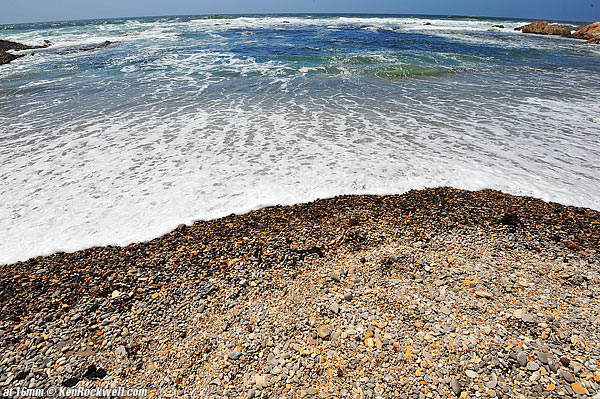
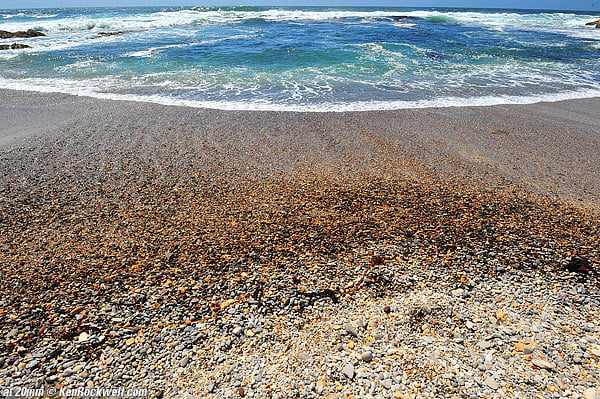
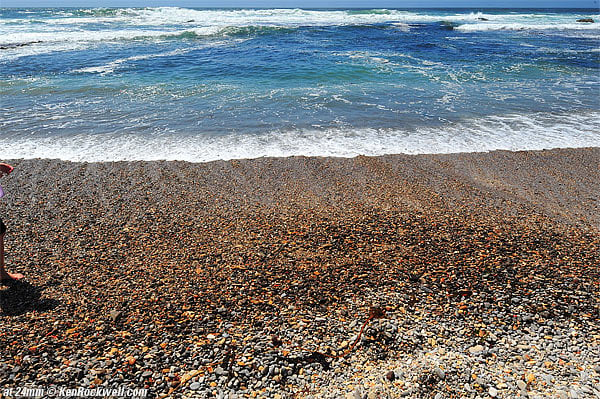
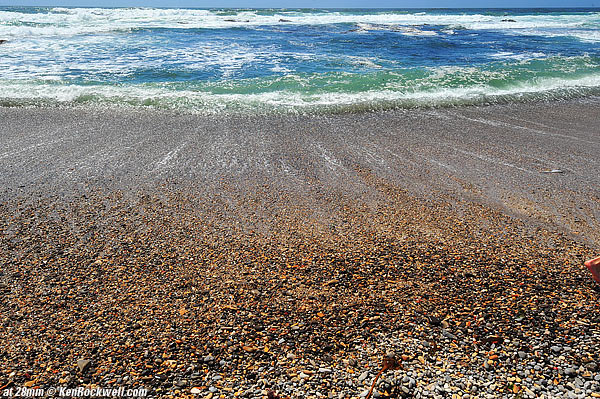
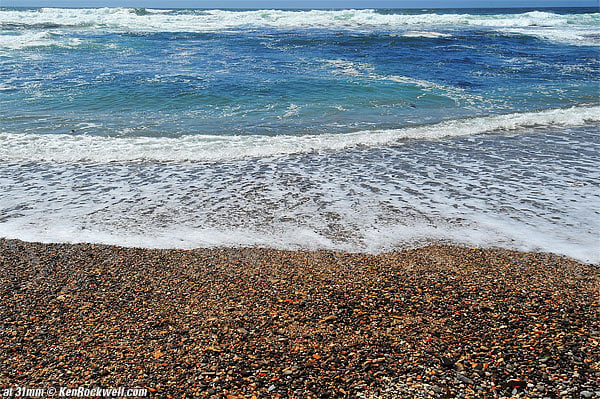

Here are brick walls for you Poindexters, also shot on full-frame. I moved away as I zoomed-in to keep the bricks about the same size, and shot this freehand as the wife and baby kept on moving at the swap meet:
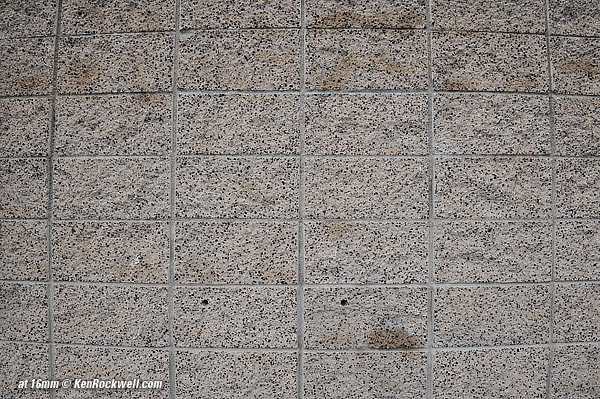
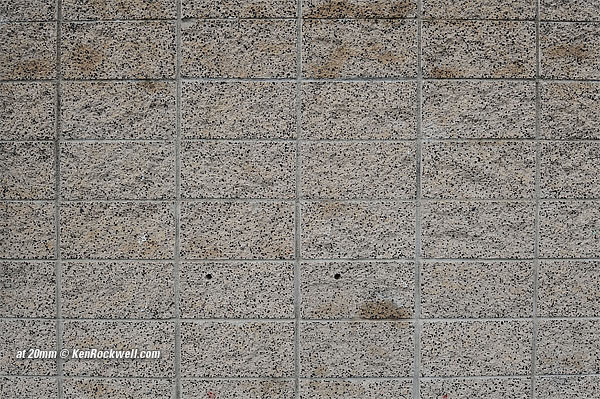
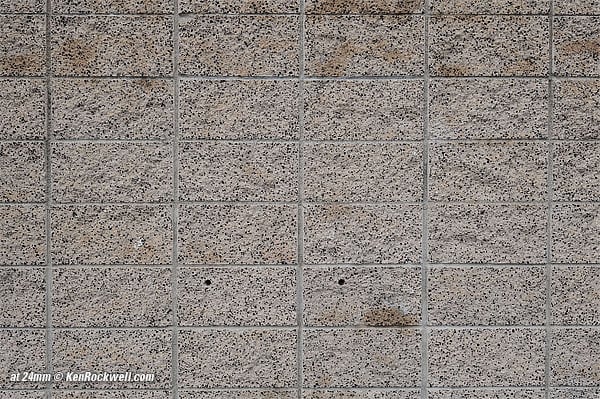
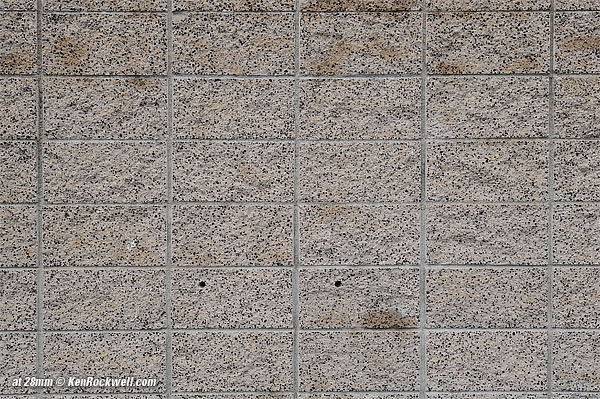
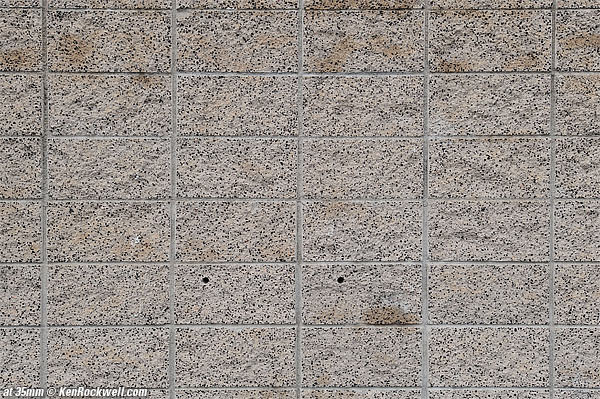
Ergonomics performance top
Nikon 16-35mm VR. enlarge.
Ergonomics are excellent, except that it's too long (5" or 125mm) and too heavy.
It's longer than the 18-200mm and only 1/2" (12mm) shorter than the 70-300mm VR.
It is significantly bigger and heavier than the 70-300mm G or 200mm f/4 AI-s.
It's so long that it's always banging into things. I need to treat this lens as if it's a telephoto.
Falloff (darker corners) performance top
Falloff is negligible. It's invisible, even at its worst, in actual photography.
I can greatly exaggerate it by shooting flat fields and then reproducing them here against another flat field, and falloff is still minor.
Nikon 16-35mm f/4 VR falloff on FX and 35mm at infinity, no correction.
© 2017 KenRockwell.com. All rights reserved. |
Filters, Use with performance top
The filter ring never moves or rotates.
There is no problem with vignetting, even with a thick rotating filter like a grad.
On FX, you're only almost starting to get the tiniest bit of vignetting with a rotating 7mm-thick (excluding male threads) filter at 16mm.
If you stack a colored filter and a rotating filter, like an 85C and a grad for a total thickness of 12mm (excluding male threads), you'll get vignetting on FX at 21mm or shorter. Shoot from 22mm through 35mm and you're fine.
Don't use polarizers at the wide end. You won't get vignetting, but you will get weird bands across the sky caused by the sky's varying angles of polarization. This is a fact of nature that is exaggerated by a wide lens and a polarizer.
If you use a polarizer, keep it at the 35mm end of the zoom range.
Flash, Use with performance top
If used on a D3 with an SB-400 flash, you'll see a dark shadow in the middle of the bottom of the image when set to wider than 21mm.
Bigger flashes should cause no problem, and built-in flashes should be worse.
Used indoors, I get swell coverage with the SB-400. Even though I'd get light falloff is shooting directly at walls, I don't do that. When I shoot with a wide lens indoors, the walls, floor and ceiling are much closer to me at the sides of the image, and the light falloff from the flash thus corrects itself.
Ghosts performance top
I couldn't get any flare or ghosts shooting into the sun. Nikon has this down, even if I used a Hoya Super HMC filter over the lens.
Lateral Color Fringes performance top
There are no lateral color fringes on the D3, which would correct them if the lens had any.
Macro performance top
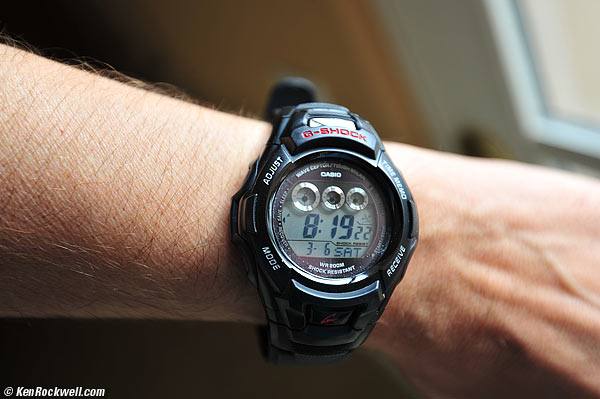
Rockwell's watch on FX. This would be even tighter on a DX camera.
It gets to one-quarter life-size, on-sensor, which is this close on FX.
It's a wide lens, which is funny because its making my watch look bigger (closer) and my wrists look smaller (father away).
Mechanics and Construction performance top
Nikon 16-35mm VR. enlarge.
My Nikon 16-35mm f/4 VR has a plastic exterior. It feels and sounds exactly like the material with which the 24-120mm VR and 18-200mm VR are clad.
It is completely different from the metal alloy with which the exteriors of the 24-70mm f/2.8 AFS, 17-35mm f/2.8 AF-S and most of the the 14-24mm are clad.
I'm not reading this off the internet; I'm looking at all of these lenses sitting right here in front of me.
Nikon has claimed that the 16-35mm has a magnesium alloy barrel, but Nikon's PR is either mistaken, or referring to the interior, not exterior, barrel.
Either I have a special one-of-a-kind collectable plastic version, or they all have plastic exteriors.
The interior is a different matter, and there seems to be plenty of metal inside, but not on the outside. You folks shooting outdoors in Norway should appreciate this.
My only whine about plastic is that the markings eventually wear off. Plastic weighs less than metal, so plastic on the outside is good. Plastic bounces when dropped; it doesn't stay bent and bung up the action. Filter threads are better in metal (they are plastic on the 16-35mm), but otherwise, plastic outer cases are fine in my book.
Good lenses, like manual-focus lenses, have only one barrel, but AF lenses have inner and outer barrels. The outside of a modern AF lens is just a dust jacket and rarely structural.
If you want your gear built like a tank, shoot the D3X, the 17-35mm f/2.8 AF-S, the 24-70mm f/2.8 AFS, the 50mm f/1.2 AI-s and the 70-200mm f/2.8 VR II. The less expensive gear is made of plastic because it weighs less and saves money. If you want tough, Nikon still delivers in its pro gear.
The Nikon 16-35mm f/4VR is built to solid amateur standards, the same standards as the 18-200mm VR and 24-120mm VR.
The outside is entirely plastic. It's exterior isn't professional metal, like the 17-35mm f/2.8 AF-S and 24-70mm AF-S. It is solid plastic; I have no complaints, and plastic is a blessing in freezing weather.
Barrel Exterior
Plastic.
Filter Threads
Plastic.
Hood
Plastic bayonet.
Focus Ring
Plastic; rubber covered.
Zoom Ring
Solid plastic.
Depth-of-Field Scale
None.
Internals and zoom cams
Metal.
Aperture Ring
None.
Mount
Dull-chromed brass.
Markings
Paint.
Identity Plate
Embossed and planed metal.
Serial Number
Laser engraved onto bottom rear of barrel, near mount.
US versions delineated by
"US" prefix to serial number.
Rain seal at mount
Yes.
Noises When Shaken
Moderate klunking from the optics wiggling around.
Made in
Japan.
Weaknesses
None observed; a tough lens albeit with a plastic skin.
Sharpness performance top
To my pleasant surprise, this Nikon 16-35mm VR is the sharpest wide zoom I've ever used, from anyone. It is sharper than the former world standard, the old 14-24mm AFS from 2007.
If you're counting pixels, this new 16-35mm VR is significantly sharper on digital than any of the older 18-35mm, 20-35mm f/2.8 or 17-35mm f/2.8 AF-S. The improvement over the 14-24mm is subtle; the 14-24mm is also a very sharp lens.
Sorry Canon, but neither the Canon 16-35mm f/2.8 L II, 16-35mm f/2.8 L or 17-40mm f/4 L can compare either, if you're looking closely.
Somehow, Nikon has found the secret sauce to be able to design and manufacture the world's first two ultra-wide zooms, the 14-24mm and this 16-35mm, that are actually sharp over the entire image area at every setting.
Lucille's, 16mm at f/4 hand-held at 1/15 sec, ISO 1,100. original © file.
When looking at the original file for the snap above, recognize that depth-of field at f/4 and the camera's noise reduction at ISO 1,100 is what's limiting sharpness, not the lens. My D3, just like a drunk driver, focused on the pole in the middle, so most of the background isn't in focus.
Lucille's, 16mm at f/4 hand-held at 1/15 sec, ISO 1,000. camera-original © file.
The top and bottom left corners of the original file might look a little softer at 100%, but remember that these parts of the subject are closer and not in focus at f/4 as shot. Don't let the huge depth of field at f/4 and 16mm make you expect that everything is in focus, even at huge enlargements.
Except for the 14-24mm, there is no other Nikon ultrawide lens that can make images this sharp and contrasty wide-open, all the way out to the corners.
The worst I can say is that the far corners in FX get slightly less contrasty at f/4 compared to other apertures, but even that is minor. Even at f/4, it's as sharp as it can get.
If you're just taking great pictures, the sharpness difference doesn't matter, and you should be guided by size, weight and price, at which point, the 18-35mm is about as good at half the price with half the weight.
Since this new 16-35mm f/4 VR is slightly sharper than the huge 14-24mm f/2.8, it's tIme to sell the 14-24mm and buy the 16-35mm f/4, and pocket the difference before used values of the 14-24mm fall.
Bravo, Nikon!
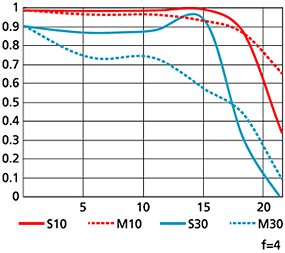 |
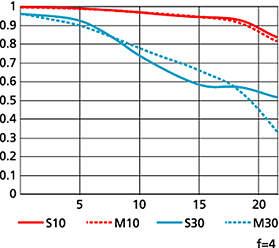 |
MTF at 16mm at f/4. |
MTF at 35mm at f/4. |
Sunstars performance top
With its 9-bladed diaphragm, this 16-35mm makes subtly magnificent 18-pointed sunstars on bright points of light.
Since it's using rounded instead of straight blades it's usually very subtle.
The 16-35mm actually stops down its diaphragm at f/4 at 16mm, so if you look at this original file, you can see the stars on some of the brightest points of light, even at f/4.
Survivability performance top
The Nikon 16-35mm is pretty tough.
Nothing moves externally.
The optics slide around inside the outer barrel as zoomed. If you take a hit on the front of the lens barrel, the impact is transmitted through the barrel around the delicate internal parts.
With a filter on the front, I don't know that it sucks in much air as zoomed, so it ought to stay relatively clean inside as the years progress.
Vibration Reduction (VR or Image stabilization) top
Turn VR off in daylight, since it increases shutter delay.
Read Why IS Is Important to understand more about what these ratings mean.
"Percent Perfectly Sharp Shots" are the percentage of frames with 100% perfect tripod-equivalent sharpness I get when I'm shooting hand-held while free-standing with no support or bracing. This is a very strict test; in actual shooting at typical print sizes I get acceptable sharpness at much slower speeds, but for the purposes of seeing how much improvement an IS system gives, this is the most precise method.
Hand tremor is a random occurrence, so at marginal speeds some frames will be perfectly sharp while others will be in various stages of blur — all at the same shutter speed. This rates what percentage of shots are perfectly sharp, not how sharp are all the frames:
| % Perfectly Sharp Shots on Z9 on FTZ (center of image) | 1 |
1/2 |
1/4 |
1/8 |
1/15 |
1/30 |
1/60 |
1/125 |
1/250 |
| Stabilization ON | 0 |
0 |
0 |
17 |
100 |
100 |
100 |
100 |
100 |
| Stabilization OFF | 0 |
0 |
0 |
0 |
17 |
50 |
100 |
100 |
100 |
I see about a 1½ stop real-world improvement.
| % Perfectly Sharp Shots on Z9 on FTZ (center of image) | 1 |
1/2 |
1/4 |
1/8 |
1/15 |
1/30 |
1/60 |
1/125 |
1/250 |
| Stabilization ON | 0 |
0 |
0 |
80 |
100 |
100 |
100 |
100 |
100 |
| Stabilization OFF | 0 |
0 |
0 |
0 |
0 |
17 |
67 |
100 |
100 |
I see about a three stop real-world improvement.
Percent perfectly sharp shots, Nikon D3 with VR OFF
2s |
1 |
1/2 |
1/4 |
1/8 |
1/15 |
|
16mm |
0 |
17 |
40 |
92 |
83 |
100 |
24mm |
0 |
0 |
0 |
50 |
83 |
100 |
35mm |
0 |
0 |
0 |
17 |
33 |
83 |
Percent perfectly sharp shots, Nikon D3 with VR ON
2s |
1 |
1/2 |
1/4 |
1/8 |
1/15 |
|
16mm |
0 |
67 |
67 |
100 |
90 |
100 |
24mm |
5 |
33 |
100 |
100 |
100 |
100 |
35mm |
0 |
40 |
40 |
100 |
83 |
83 |
Let's chart the slowest speed at which I get 50% of my shots perfectly sharp at each focal length, and with that, we can calculate how many stops we gain with VR.
"Real Stops Improvement" are how many extra stops I got, IS ON compared to IS OFF.
"Marketing Stops Improvement" isn't comparing the speed I can use from IS OFF to IS ON, but instead comparing the speed one can use with IS ON to the old-wives-tale speed of 1/focal length. That's called Lying with Statistics.
No VR |
VR ON |
Marketing Stops Improvement |
Real |
Effective Speed |
|
16mm |
1/2.5 |
1.2s |
4.3 |
1.6 |
f/2.2 |
24mm |
1/4 |
1/1.6 |
4 |
1.3 |
f/2.5 |
35mm |
1/12 |
1/2.5 |
3.8 |
2.3 |
f/1.8 |
It's easy to get sharp shots at 1/4 to 1/2 second at every focal length with VR ON, but then again, I get the same results at 1/5 - 1/15 with no VR.
The benefit of VR is only visible between 1/8 and 1 second, which is very useful for dim light. In dim light, getting an average of 1-2/3 stops of VR benefit in exchange for 1 stop lost compared to an f/2.8 lens is a winner for still subjects, since not only am I 2/3 stop ahead, the smaller aperture gives more depth-of-field as well.
Zooming performance top
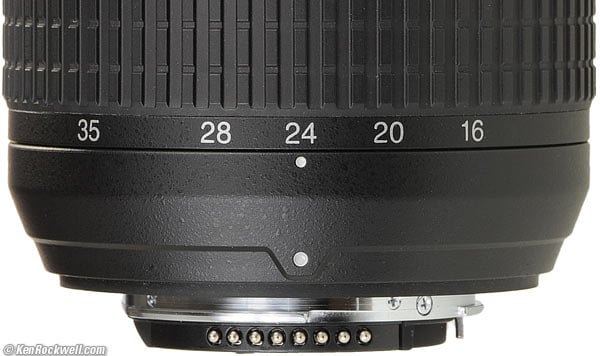
Zoom Ring, Nikon 16-35mm.
Zooming is perfect.
The focal lengths have perfect semi-logarithmic spacing, and the ring feels great. This means it's easy to select the perfect setting.
The zoom cams appear to be metal.
Focus doesn't shift as zoomed. It stays as set.
Compared
Top Sample Images Intro Format
Compatibility Specs Performance
NEW: Full-Frame Mirrorless Ultrawide Lenses Compared 25 June 2019
Full-Frame Ultrawide Lenses Compared 24 June 2017
Nikon Ultrawide Zooms Compared 08 March 2010
Sharpness Comparison to all other 18mm lenses 11 August 2010
Sharpness Comparison to all other 20mm lenses September 2010
Sharpness Comparison to all other 24mm lenses August 2010
I 'd get my 16-35 VR used at eBay (How to Win at eBay).
Nikon 17-55mm DX vs. 16-35mm VR
Readers have asked that since the 16-35mm VR is the world's sharpest ultrawide zoom, if it's a better choice for DX cameras than the 17-55mm f/2.8 DX.
NO!
For DX, the 17-55mm f/2.8 DX is much better. Why is the 17-55/2.8 a better choice for DX if the 16-35mm VR is the world's sharpest ultrawide zoom?
One must read my words precisely. The 16-35 really is the world's sharpest ultrawide zoom, but as you need to know, "ultrawide" and "zoom" are each weasel words that exclude other lenses from the comparison. If you remove the word "ultrawide," the world's sharpest zoom is the Canon 70-200mm f/4 L IS. If you remove "zoom" but leave in "ultrawide," the world's sharpest ultrawide lens for 24x36mm format is the LEICA ELMARIT-M 21mm f/2.8 ASPH. If you remove the word "zoom" and "ultrawide" the LEICA APO-SUMMICRON-M 90mm f/2 ASPH is the world's sharpest 24x 36mm format lens. Of course large-format (4x5") lenses are even sharper. As everyone in marketing, but few members of the public know, weasel words are everything. The worst is when car companies claim a car is the best "in its class," and never bother to tell you that they defined their own class which only includes cars worse than theirs.
In this case, the 17-55mm is not an ultrawide, and it's as sharp as the 16-35mm on DX cameras. Sharpness isn't the issue here. Ultrawide zooms are the most difficult lenses to make, and therefore they are softer in the corners than any other photographic lens.
The Nikon 16-35 VR is the world's best ultrawide zoom, far better than the older-generation Canon 17-40mm f/4 L and Canon 16-35mm f/2.8 L II I also own — when used as ultrawide lenses on full-frame.
When used on DX, these expensive full-frame ultrawides simply become midrange zooms. On DX, we need to compare these to other DX midrange zooms. When we compare full-frame ultrawides to DX midrange lenses, the full-frame ultrawides are much bigger, heavier and more expensive because they have to cover a larger format, and they have more restricted zoom ranges. They aren't any sharper, in fact, they probably are less sharp than the dedicated DX lenses.
I never, ever suggest using full-frame wide lenses on DX cameras. This is why Nikon invented DX lenses: for better optical, size, weight and price performance on the smaller formats.
Recommendations
Top Sample Images Intro Format
Compatibility Specs Performance
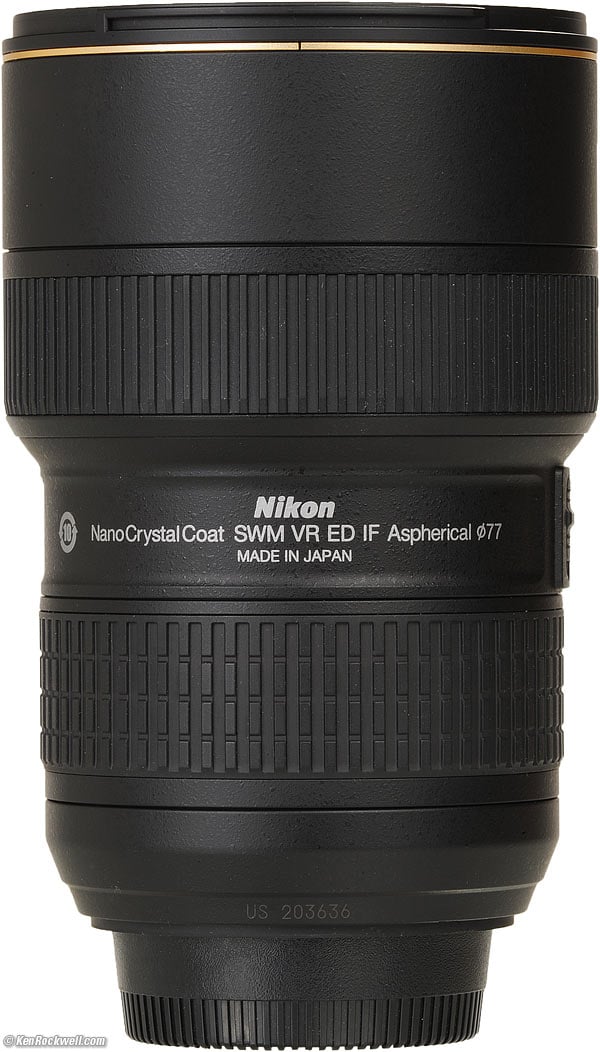
Bottom, Nikon 16-35 VR.
I 'd get my 16-35 VR used at eBay (How to Win at eBay).
This 16-35mm is the sharpest and best-handling Nikon ultrawide zoom ever made for DSLRs and 35mm SLRs.
f you shoot FX, or 35mm on a modern camera, get one of these 16-35mm lenses today. It's my favorite Nikon ultrawide. It's slightly sharper than the 14-24mm, adds VR, uses normal filters and is smaller, lighter and less expensive.
Turn VR off in daylight, since it increases shutter delay.
The huge 14-24mm is a special-purpose lens. I don't suggest it for general use; I suggest this 16-35mm.
Skip this full-frame 16-35mm for DX. The 10-24mm DX or 10-20mm are much better for use as wide-angles on DX and cost much less.
If you're a backpacker, the 18-35mm AF-S or 20mm f/1.8 weigh less, but have no VR.
I never use the hood. I leave it in the box for resale time.
I'd leave either a 77mm Nikon Clear (NC - UV) filter or a 77mm Hoya multicoated HD3 UV, which uses hardened glass and repels dirt and fingerprints, on the lens at all times.
For less money, the B+W 77mm 010 is an excellent filter, as are the multicoated version and the basic multicoated Hoya filters, but the Hoya HD3 is the toughest and the best.
Filters last a lifetime, so you may as well get the best. The Hoya HD3 stays cleaner than the others since it repels oil and dirt.
I 'd get my 16-35 VR used at eBay (How to Win at eBay).
This all-content, junk-free website's biggest source of support is when you use those or any of these links to approved sources when you get anything, regardless of the country in which you live. Nikon does not seal its boxes in any way, so never buy at retail or any other source not on my personally approved list since you'll have no way of knowing if you're missing accessories, getting a defective, damaged, returned, store demo or used lens. I use the stores I do because they ship from secure remote warehouses where no one gets to touch your new camera before you do. Buy only from the approved sources I use myself for the best prices, service, return policies and selection.
Thanks for helping me help you!
Ken Rockwell.
© Ken Rockwell. All rights reserved. Tous droits réservés. Alle Rechte vorbehalten.
Help Me Help You
I support my growing family through this website, as crazy as it might seem.
The biggest help is when you use any of these links when you get anything. It costs you nothing, and is this site's, and thus my family's, biggest source of support. These places always have the best prices and service, which is why I've used them since before this website existed. I recommend them all personally.
If you find this page as helpful as a book you might have had to buy or a workshop you may have had to take, feel free to help me continue helping everyone.
If you've gotten your gear through one of my links or helped otherwise, you're family. It's great people like you who allow me to keep adding to this site full-time. Thanks!
If you haven't helped yet, please do, and consider helping me with a gift of $5.00.
As this page is copyrighted and formally registered, it is unlawful to make copies, especially in the form of printouts for personal use. If you wish to make a printout for personal use, you are granted one-time permission only if you PayPal me $5.00 per printout or part thereof. Thank you!
Thanks for reading!
Ken Rockwell.
